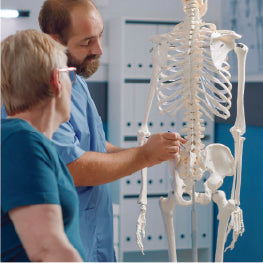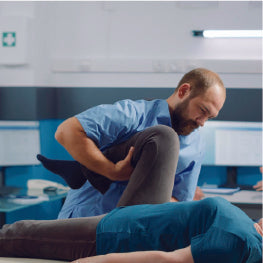Hip Labral Tear Injury Overview
Are you worried about a hip labral tear?
Our injury overview covers all the essentials, including what it is, symptoms, causes, and more.
Related Articles
- Labral Tear: Injury Overview
- The Best Hip Labral Treatments
- The Best Hip Labral Tear Exercises
- Physical Therapy for a Hip Labral Tear
About 22-55% of people who have symptoms of groin or hip pain have a hip labral tear.
The labral is a cartilage ring at the edge of the hip socket. It provides stability to the hip joint and acts as a shock absorber. When there is a tear in the labrum, fluid that lubricates the system leaks out and increases pressure.
Initially, someone will feel pain in the groin or hip area. However, the impact of a hip labral tear may involve more than discomfort. Depending on the severity of the tear, it can impact proper hip movement and range of motion.
A hip labral tear can impact regular hip movements, such as outward and inward rotation. Reduced range of motion, hip joint instability, and discomfort can all adversely affect quality of life. In addition, having a history of a hip labral tear may also increase the risk of developing hip arthritis in the future.
A structural abnormality of the hip joint may increase your risk of developing a labral tear. It can also occur from trauma to the joint or from a repetitive motion.
The recovery from a hip labral tear may vary. In general, tears that cause symptoms require surgery. Recovery may depend on the type of surgical procedure. Individuals who undergo surgery may be able to return to their normal activities in about two to four months.
It is helpful to understand more about hip labral tears to recognize symptoms and receive prompt medical care. The article below covers hip labral tears, including symptoms, causes, risk factors, and diagnosis.

What is a Hip Labral Tear?
A hip labral tear involves an injury to the hip labrum. The labrum is susceptible to injury from forces that occur with falling, pivoting, and twisting motions.
The hip labrum is the cartilage ring that surrounds the hip's acetabulum socket.
The hip labrum plays a vital role in overall hip function. It provides protection, stability, and support for the hip joint.
For instance, the hip labral does the following:
- Protects the bones from rubbing against each other during movement
- Promotes range of motion in the hip, such as allowing the thing to rotate inward, forward, backward, and externally
- Allows for smooth movement between the ball and socket
Doctors categorize types of hip labral tears based on where the tear occurs. Anterior tears occur on the side of the joint closer to the abdomen. This type of tear is associated with frequent movements, such as pivoting.
Posterior tears occur on the side of the joint closer to the back. They are associated with movements, such as repetitive squatting.
Most tears occur on the anterior side, likely because it is thinner and wider than the posterior.
Hip conditions and injuries may have similar symptoms. However, it is essential to distinguish between conditions to treat them appropriately. For instance, hip bursitis and a hip labral tear may share some symptoms.
But the difference between hip bursitis and labral tear is hip bursitis involves inflammation of the bursae. The bursae are the tiny sacs of fluid that cushions the hip joint. It does not include the labrum.

Hip Labral Tear Causes and Risk Factors
A hip labral tear can occur when the labrum receives excess force. It is more likely to happen in people with specific structural differences in the hip.
Other hip conditions can also increase the likelihood of developing a hip labral tear. For instance, a hip impingement, also called a femoroacetabular impingement, is sometimes linked to a labral tear in the hip.
A hip impingement develops when the ball of the hip pinches against the cup of the hip called the acetabulum. In some cases, hip impingement can lead to damage to the labrum that surrounds the acetabulum. There are also some gender differences related to a labrum tear. Women are more likely to develop a tear than men.
In addition, trauma to the hip and repetitive motions can also lead to a hip labral tear. Certain sports and activities that require frequent hyperextension or external rotation also increase the risk of a tear. Some tears are also related to running and sprinting.
Hip labral tears in athletes can occur from repetitive trauma or an isolated traumatic event. People who play the following sports may be at an increased risk:
- Hockey
- Soccer
- Gymnastics
- Dance
- Football
In some cases, doctors do not identify a known cause of the injury. Up to 74.1% of hip labral tears are unrelated to a specific cause or event.

Hip Labral Tear Symptoms
The severity of symptoms may depend on the tear size and whether the tear is posterior or anterior.
Hip labral tear symptoms may include the following:
- Pain when rotating the hip
- Sharp pain located in the groin area when bringing the knees to the chest or pivoting or twisting
- Dull pain that becomes worse after activities, such as walking or prolonged sitting
- Pain may extend towards the glutes or the knee
- Hip instability
- A clicking sound when moving the hips
- Stiffness in the hips

Hip Labral Tear Diagnosis
Diagnosing a hip labral tear starts with an examination by a healthcare provider. The provider will take a medical history, ask about symptoms, and perform a physical exam.
During the physical exam, the provider checks for pain with hip flexion, adduction, and external rotation. The provider may ask a patient to stand, bend, or walk to assess strength, range of motion, and if any movements cause pain.
The healthcare provider evaluates the hip joint to determine if there is an underlying cause of the injury.
Advanced imaging tests also play a role in getting an accurate diagnosis. Imaging tests take pictures of the hip joint and surrounding tissues. Tests may include:
- X-ray
- MRI
- Ultrasound

Hip Labral Tear Recovery
The recovery from a hip labral tear may vary based on the extent of the tear. A common question is, can a hip labral tear heal on its own? The answer is no. Even small tears do not fully heal on their own. Surgery is the only way to heal the torn cartilage.
A doctor may suggest medical management for small tears that cause few symptoms. Medical management may include:
- Steroids
- Physical therapy
- Over-the-counter anti-inflammatory medications
Hip labral tear recovery time without surgery may vary but can take a few weeks.
When pain or other symptoms occur with a hip labral tear, surgery is an option. The recovery from a hip labral tear may vary. In general, tears that cause symptoms require surgery. Recovery may depend on the type of surgical procedure. Individuals who undergo surgery may be able to return to their normal activities in about two to four months.

How Can I Prevent a Hip Labral Tear?
Some hip labral tears develop due to sudden trauma to the hip joint. So, it may not be possible to prevent all hip labral tears. However, there are some steps individuals can take to reduce the risk of a tear.
Tips to prevent or reduce the risk of a hip labral tear include:
- Warm up before participating in vigorous workouts or activities.
- Cooldown after athletic activities or workouts.
- Gradually increase intensity in athletic activities.
- Wear proper protective equipment for the sporting event you are participating in.
- Stop activity if you experience hip pain during sports or exercise.
- Allow your body time to recover after intense workouts.
- Use a walker or cane if you have problems walking and are at risk of falling.
Conclusion
A hip labral tear involves excess force or injury to the hip labrum. The hip labrum is a tough cartilage ring that surrounds the hip acetabulum.
Common mechanisms of injury include trauma to the area of repetitive injury. People who participate in activities requiring frequent twisting and pivoting, such as dancers, soccer, and hockey players, are at increased risk.
Symptoms can include pain, stiffness, and hip instability. It can affect the ability to do everyday activities like walking, sitting, and sports.
Getting an accurate diagnosis as soon as possible is vital to receive appropriate treatment for optional recovery. In mild cases, treatment may include physical therapy and pain management. However, surgical intervention is needed to repair a tear.
Frequently Asked Questions
Does a labral tear lead to a hip replacement?
When the labrum tears, it can cause hip instability and pain. It can increase the risk of developing osteoarthritis. Hip osteoarthritis can sometimes become a debilitating condition and interfere with quality of life. Doctors may recommend a hip replacement in some instances of hip osteoarthritis.
Can a hip labral tear cause back pain?
Some people who develop a hip labral tear may feel pain in the lower back. In addition to the hip, pain may also radiate to the groin. Because of the back pain, it can affect the way someone moves. Unconscious changes in gait and posture can also affect the back and increase pain.
Are hip labral tears common?
Hip labral tears are relatively common. Researchers believe a hip labral tear is responsible for hip or groin pain in about 22-55% of cases.
How serious is a hip labral tear?
A hip labral tear can be severe. It can interfere with everyday activities and, without treatment, can worsen. It can increase the risk of hip arthritis and chronic pain. Because it can become severe, it is best to seek treatment early.
About the Author

MaryAnn DePietro CRT is a licensed respiratory therapist with over 15 years of clinical experience in critical care, emergency medicine, and pulmonary rehabilitation. She is also an American Council on Exercise certified personal trainer and holds specialty certifications in orthopedics, senior fitness, and weight management. MaryAnn has a degree in Rehabilitation from Penn State University and a degree in respiratory therapy.
In addition to her clinical experience, she has written extensively about all things medical, as well as health, fitness, and aging for various websites, magazines, and newspapers.
About Carex Health Brands
Carex is your one-stop shop for home medical equipment and for products that assist caregivers with providing the best possible support and care for their loved ones. Carex Health Brands has been the branded leader in in-home, self-care medical products for over 35 years. Our goal is to improve the lives of our customers by bring them quality products that bring dignity back to their lives. With our three nationally distributed brands, Carex Health Brands serves national, regional and independent food, drug and mass retailers along with wholesalers, distributors and medical dealers.

